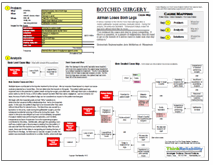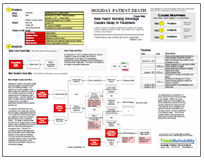In a tragic case of incorrect diagnosis, a 16-year-old patient died January 24, 2013, eleven months after being diagnosed with “migraines”. In fact, the patient had a rare brain tumor (known as a disseminated oligodendroglioma-like leptomeningeal tumor). She died eight days after receiving an MRI that finally properly diagnosed the causes of her headaches, numbness, nausea and eyesight problems.
It’s unclear if earlier diagnosis would have saved the life of the patient. Though the prognosis is poor for a leptomeningeal tumor, a oligodendroglioma that is treated before it is disseminated gives a long-term survival chance to 80-100%. The tumor had disseminated once it was found on the MRI, eleven months after the patient was diagnosed with migraines. However, even if her prognosis was poor, the patient could have spent the last eleven months of her short life enjoying time with her family and friends, instead of making 24 trips to 13 different doctors and, in one particularly devastating appointment, being accused of “putting the symptoms on”.
Although the coroner at the inquest said there was no need to make a formal recommendation for changes at the hospital that failed to diagnose the patient, a spokesperson for that hospital said “In the next few weeks, many of the clinicians who looked after Natasha will be meeting to discuss this sad case and ensure that any opportunities for learning are not missed.”
It is hoped that these opportunities for learning can reduce the possibility of another patient suffering as this patient did, due to a misdiagnosis. Misdiagnosis is a common source of medical error. According to an article by Michael Astion, MD, PhD, “Available data suggests that misdiagnoses occur in 15% or more of clinical cases, but overall there is very limited data on the frequency of misdiagnosis in medicine.” Especially in rare clinical cases such as this one, sharing details of the disease and diagnosis may help other clinicians in the same position.
In order to effectively determine lessons learned and improvements that can be made, the details of a case need to be presented clearly and concisely. I’ve put together the details of the case in a Cause Map, which uses cause-and-effect to demonstrate the linkage of the issues that led to the tragedy discussed here.
In a blog discussing the cases and possible responses, Suzanne Leigh suggests that if an MRI was denied, other cheaper alternatives, such as a CT scan, be considered. She also suggests a much more thorough review to “ensure that in the future, scans are not withheld from patients with potentially life-threatening conditions” and that the hospital involved should “study the flaws in the system and human errors that led to the failure of 13 doctors to order a diagnostic MRI that would have resulted in emergency treatment earlier in the disease’s progression”. Given the tragedy of this case, the suggestions seem far more appropriate than the treatment of the patient over the last year of her life.
To view the Outline and Cause Map, please click “Download PDF” above. Or click here to read more.






